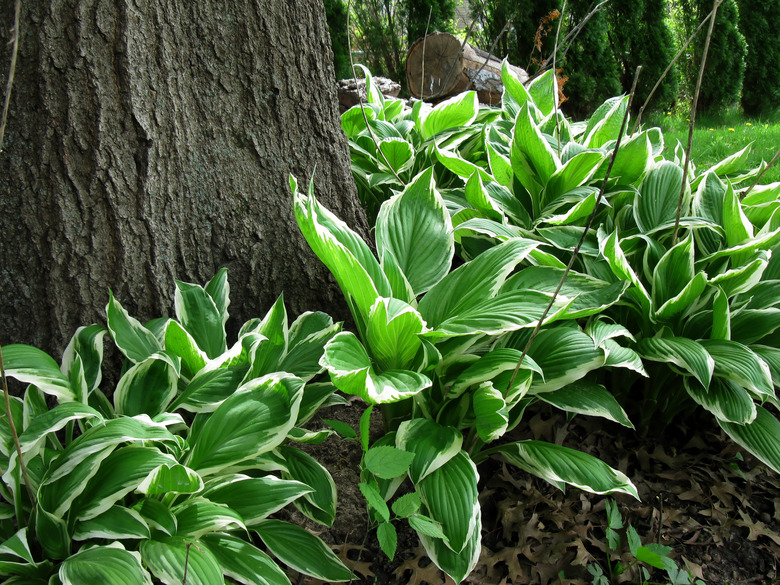When Should I Plant Hostas?
Hostas (Hosta spp.) are popular perennials typically planted or transplanted in early spring and early fall. Gardeners have numerous species and roughly 4,000 different types of hosta cultivars from which to choose, with each type offering a wide array of leaf sizes, shapes, colors and textures. Some hostas even produce fragrant blooms.
Also known as plantain lilies, hostas are simple to care for and perfect for shade gardens. They are hardy in U.S. Department of Agriculture plant hardiness zones 3 through 9, depending on species and cultivar.
Spring and Fall Planting
Spring and Fall Planting
The best times to plant or transplant hostas is in early spring after the last average annual frost date has passed. A late-spring frost can damage the plants' new leaves, however. Place plastic pots over emerging plants if temperatures are going below freezing.
Hostas also can be planted or transplanted in early fall, or at least six weeks before the first average annual frost date. This gives enough time for the plants to develop strong root systems before the ground freezes.
Sun and Shade
Sun and Shade
Although hostas do well in some shade, they also like a little sun. Most types do especially well in locations with morning sunlight and afternoon shade. In full afternoon sunlight, hostas can find themselves with leaf burn during summer.
If you have a particular planting spot in mind, choose hosta by leaf color. Hostas with blue leaves grow best in shade, and those with gold or yellow leaves prefer more sun exposure.
Planting Hostas
Planting Hostas
Hostas thrive in loamy, slightly acidic, well-draining soil. Incorporate 6 inches of compost or organic matter to 12 inches of soil. The optimal pH level for hostas is 6.5 to 7.5. Make each to dig each hole's width twice the size of the plant's root ball at maturity, as indicated on the plant's label.
Tap around all sides of the container holding a hosta to loosen the soil and roots before removing the plant. Use fingers to loosen tangled root balls if necessary, and shake any loose soil from the roots. Do not add the loose soil to the planting hole. Plant your hosta in the hole at the same soil depth at which the plant grew in its container. Typically, the first set of leaves above the roots should be at ground level.
If your hosta came with bare roots, soak the roots in lukewarm water for 30 minutes before planting. Build a small mound in the bottom of the planting hole, and spread the roots over the mound. Fill the hole with soil and water. Saturate the top 6 inches of soil around the plant with water.
Watering Hosta
Watering Hosta
Water hosta as needed, but at least once per week if there's no rainfall, depending on the dryness of the soil. Soil should be moist and not dry. Early morning or in the evening when the sun begins to set is the best time to water the plants. Signs that hostas are underwatered include drooping leaves and burned leaf tips.
Spring Growth
Spring Growth
Beginning in March, hostas alternate between producing leaves and roots. They have one or two cycles, or flushes, during which three or four oversized leaves emerge. These leaves take several weeks to open.
After the first flush's leaves open, the plants begin to harden off, or become accustomed to the conditions, and produce waxy purple pigments. At the completion of this leaf phase, the plants start producing white roots above roots they produced the previous year.
Soon the second flush begins with the emergence of three or four leaves. Keep the plants well-watered because the leaves consist mostly of water.
Summer Flowers
Summer Flowers
Hostas bloom for about three or more weeks in summer. Each lily-like blossom opens along a tall, vertical flower stem. Bees pollinate the flowers, which then create seedpods, although some hybrid cultivars do not produce seeds. The black seeds inside the seedpods ripen in six to eight weeks.
Fall Preparation
Fall Preparation
When hostas' yellow pigments become visible and their green leaves turn to gold in fall, it signals the plants are preparing for winter. At that time, it is too late to plant or transplant them.
Before the first snow, remove all dead foliage and stems from the hostas. Apply a 2- to 3-inch-thick layer of mulch over the soil of hostas you planted or transplanted in spring or fall to protect the plants during winter.
Winter Dormancy
Winter Dormancy
During winter, hostas remain dormant, with no above-ground growth of any kind. Hostas require roughly 700 hours of temperatures below 40 degrees Fahrenheit. The longer the cold period lasts during their dormancy, the stronger the plants emerge in spring.
